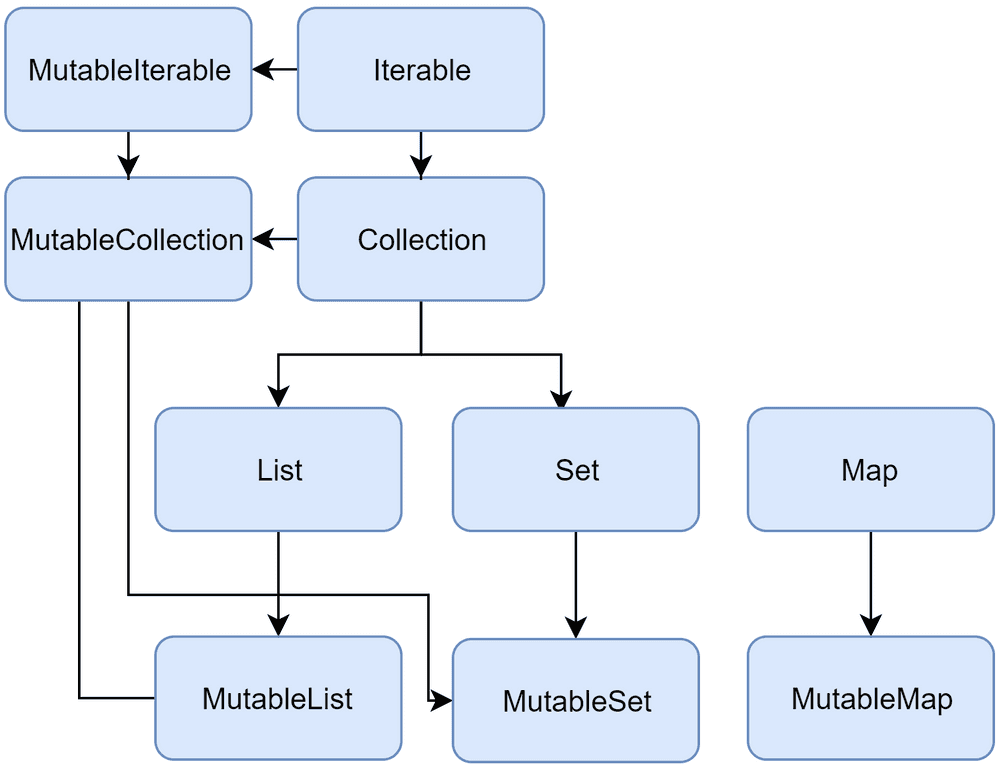Collection(콜렉션)은 대부분의 프로그래밍 언어에 있는 자료구조입니다. 자바의 List, Map, Set 등을 Collection이라고 합니다. Collection은 Generic으로 구현이 되어 다양한 타입과 함께 사용될 수 있습니다.
코틀린의 Collection은 기본적으로 Mutable(변할 수 없는)과 Immutable(불변의)을 별개로 지원합니다. Mutable로 생성하면 추가, 삭제가 가능하지만, Immutable로 생성하면 수정이 안됩니다.
코틀린의 콜렉션들은 아래 그림과 같은 상속 구조 갖고 있습니다.
 (출처: kotlinlang.com)
(출처: kotlinlang.com)
이 글에서는 콜렉션을 한번씩 사용해보았다고 가정하고, 코틀린에서 콜렉션을 어떻게 사용하는지 예제와 함께 알아보겠습니다.
List
List는 데이터가 저장하거나 삭제될 때 순서를 지키는 Collection입니다. List는 Mutable(변할 수 없는)과 Immutable(불변의)을 모두 지원합니다.
List : Immutable(수정할 수 없는 객체, 불변의)
listOf<타입>(아이템, )로 Immutable List를 생성 및 초기화를 할 수 있습니다. 코틀린은 아이템의 타입을 추론하기 때문에 타입을 생략해도 됩니다.
Immutable이기 때문에 get만 가능합니다. List의 getter는 자바처럼 get(index)도 지원하고 배열처럼 [index]도 지원합니다.
코틀린은 간결하고 직관적인 배열같은 표현 방식을 선호합니다.
val fruits= listOf<String>("apple", "banana", "kiwi", "peach")
// val fruits= listOf("apple", "banana", "kiwi", "peach") -> 타입 생략 가능
println("fruits.size: ${fruits.size}")
println("fruits.get(2): ${fruits.get(2)}")
println("fruits[3]: ${fruits[3]}")
println("fruits.indexOf(\"peach\"): ${fruits.indexOf("peach")}")위의 코드를 실행한 결과입니다.
fruits.size: 4
fruits.get(2): kiwi
fruits[3]: peach
fruits.indexOf("peach"): 3List : Mutable(수정가능한 객체, 변할 수 있는)
수정가능한 List는 mutableListOf로 선언합니다. listOf와 대부분 비슷하지만, 추가 및 삭제가 가능합니다.
자바의 Collection에 익숙하시다면 remove, add, addAll, removeAt 등은 이미 알고 계실 것입니다.
val fruits= mutableListOf<String>("apple", "banana", "kiwi", "peach")
fruits.remove("apple")
fruits.add("grape")
println("fruits: $fruits")
fruits.addAll(listOf("melon", "cherry"))
println("fruits: $fruits")
fruits.removeAt(3)
println("fruits: $fruits")위의 코드를 실행한 결과입니다.
fruits: [banana, kiwi, peach, grape]
fruits: [banana, kiwi, peach, grape, melon, cherry]
fruits: [banana, kiwi, peach, melon, cherry]그 외에도 replace, replaceAll, contains, forEach 등의 메소드도 지원합니다.
Set
Set은 동일한 아이템이 없는 Collection입니다. Set의 아이템들의 순서는 특별히 정해져 있지 않습니다. Set은 null 객체를 갖고 있을 수 있습니다. 동일한 객체는 추가될 수 없기 때문에 null도 1개만 갖고 있을 수 있습니다. List와 같이 Set도 Immutable과 Mutable을 별개로 지원합니다.
Set : Immutable
setOf<타입>(아이템들)로 객체를 생성할 수 있습니다. 다음과 같이 객체 아이템들을 확인할 수 있습니다.
val numbers = setOf<Int>(33, 22, 11, 1, 22, 3)
println(numbers)
println("numbers.size: ${numbers.size}")
println("numbers.contains(1): ${numbers.contains(1)}")
println("numbers.isEmpty(): ${numbers.isEmpty()}")실행 결과입니다.
[33, 22, 11, 1, 3]
numbers.size: 5
numbers.contains(1): true
numbers.isEmpty(): falseforEach 또는 Iterator 등으로 모든 객체를 탐색할 수도 있습니다.
Set : Mutable
Mutable은 mutableSetOf<타입>(아이템들) 로 생성할 수 있습니다. Mutable이기 때문에 추가, 삭제가 가능합니다.
List와 비슷한 메소드들을 지원합니다.
val numbers = mutableSetOf<Int>(33, 22, 11, 1, 22, 3)
println(numbers)
numbers.add(100)
numbers.remove(33)
println(numbers)
numbers.removeIf({ it < 10 }) // 10 이하의 숫자를 삭제
println(numbers)실행 결과 입니다.
[33, 22, 11, 1, 3]
[22, 11, 1, 3, 100]
[22, 11, 100]Map
Map은 key와 value를 짝지어 저장하는 Collection입니다. Map의 key는 유일하기 때문에 동일한 이름의 key는 허용되지 않습니다.에 Map 또한 Immutable과 Mutable을 별개로 지원합니다.
Map : Immutable
Map은 mapOf<key type, value type>(아이템)로 생성할 수 있습니다. 아이템은 Pair객체로 표현하며, Pair에 key와 value를 넣을 수 있습니다.
Pair(A, B)는 A to B로 간단히 표현이 가능합니다. 이런 문법이 가능한 것은 to가 Infix이기 때문입니다.
val numbersMap = mapOf<String, String>(
"1" to "one", "2" to "two", "3" to "three")
println("numbersMap: $numbersMap")
val numbersMap2 = mapOf(Pair("1", "one"), Pair("2", "two"), Pair("3", "three"))
println("numbersMap2: $numbersMap2")
// 실행해보면 모두 동일한 값을 갖고 있습니다.
// numbersMap: {1=one, 2=two, 3=three}
// numbersMap2: {1=one, 2=two, 3=three}Map의 데이터를 읽는 것도 다른 Collection과 유사합니다. getter는 get(index)와 [index]를 모두 지원합니다. 코틀린은 배열 방식을 선호합니다.
keys와 values는 key와 value만으로 구성된 Set을 리턴해줍니다.
val numbersMap = mapOf<String, String>(
"1" to "one", "2" to "two", "3" to "three")
println("numbersMap.get(\"1\"): ${numbersMap.get("1")}")
println("numbersMap[\"1\"]: ${numbersMap["1"]}")
println("numbersMap[\"1\"]: ${numbersMap.values}")
println("numbersMap keys:${numbersMap.keys}")
println("numbersMap values:${numbersMap.values}")
for (value in numbersMap.values) {
println(value)
}실행 결과입니다.
numbersMap.get("1"): one
numbersMap["1"]: one
numbersMap["1"]: [one, two, three]
numbersMap keys:[1, 2, 3]
numbersMap values:[one, two, three]
one
two
threeMap : Mutable
Mutable은 mutableMapOf<key type, value type>(아이템)로 생성합니다. 객체 추가는 put 메소드이며, Pair를 사용하지 말고 인자로 key와 value를 넣어주면 됩니다.
put도 배열 방식을 지원합니다. 그 외에 자바의 Map과 유사합니다.
val numbersMap = mutableMapOf<String, String>(
"1" to "one", "2" to "two", "3" to "three")
println("numbersMap: $numbersMap")
numbersMap.put("4", "four")
numbersMap["5"] = "five"
println("numbersMap: $numbersMap")
numbersMap.remove("1")
println("numbersMap: $numbersMap")
numbersMap.clear()
println("numbersMap: $numbersMap")실행 결과 입니다.
numbersMap: {1=one, 2=two, 3=three}
numbersMap: {1=one, 2=two, 3=three, 4=four, 5=five}
numbersMap: {2=two, 3=three, 4=four, 5=five}
numbersMap: {}Collection
List와 Set은 Collection을 상속합니다. 이 클래스들은 Collection에 대입할 수 있기 때문에 아래와 같이 사용할 수 있습니다.
fun printAll(strings: Collection<String>) {
for(s in strings) print("$s ")
println()
}
val stringList = listOf("one", "two", "one")
printAll(stringList)
val stringSet = setOf("one", "two", "three")
printAll(stringSet)실행 결과 입니다.
one two one
one two three정리
코틀린의 Collection인 Map, Set, List에 대해서 알아보았습니다. 자바와 다른 것은 Mutable과 Immutable을 구분하여 지원한다는 점입니다. 그 외의 지원하는 메소드는 자바와 거의 유사합니다.
참고
Related Posts
- Kotlin - 배열에서 최소 값, 최대 값 찾기
- Kotlin - 2차원 배열 선언, 초기화 방법
- Kotlin - 배열 선언, 초기화 방법
- Kotlin - 리스트에서 최대, 최소 값 찾기
- Kotlin - for 반복문, 배열/리스트 순회
- Kotlin - 리스트, 배열 길이 가져오기
- Kotlin - Timer, 주기적으로 함수 실행
- Kotlin - sleep, 쓰레드 몇 초 지연
- Kotlin - Thread 생성 및 실행
- Kotlin에서 정규표현식 사용하기
- Kotlin - 문자열 길이 계산
- Kotlin - 문자열 비교 방법(equals, ==, compareTo)
- Kotlin - 2개의 배열 하나로 합치기
- Kotlin - 디렉토리의 모든 파일 리스트 출력
- Kotlin - 2개의 List 하나로 합치기
- Kotlin - 리스트 정렬 방법 (sort, sortBy, sortWith)
- Kotlin - 문자열 뒤집기 (Reverse String)
- Kotlin - 랜덤 숫자 생성 (Random, SecureRandom)
- Kotlin - Range, 숫자 범위 표현
- Kotlin - 음수를 양수로 변환, math.abs()
- Kotlin - List를 Set로 변환
- Kotlin - Set를 List로 변환
- Kotlin - 문자열에서 숫자(int)만 추출하는 방법
- Kotlin - Map을 List로 변환하는 방법
- Kotlin - File, Directory가 존재하는지 확인
- Kotlin - List를 Map으로 변환
- Kotlin - List의 중복 요소 제거
- Kotlin - List를 Array로 변환
- Kotlin - 엘비스 연산자 (Elvis Operation)
- Kotlin - Array를 List로 변환
- Kotlin - String을 Double으로 변환
- Kotlin - String을 Float으로 변환
- Kotlin - String을 Int로 변환
- Kotlin - String을 Long으로 변환
- Kotlin - String Null 또는 Empty 체크